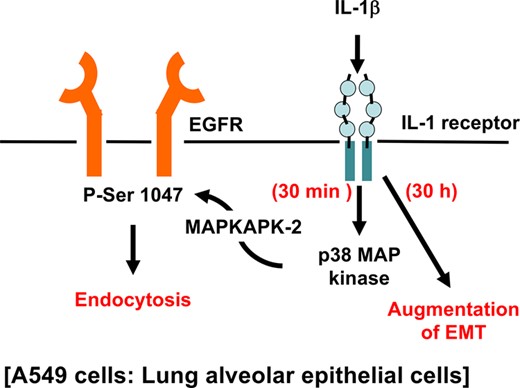-
Views
-
Cite
Cite
Izumi Nakayama, Sayomi Higa-Nakamine, Ayako Uehara, Kazuhiro Sugahara, Manabu Kakinohana, Hideyuki Yamamoto, Regulation of epidermal growth factor receptor expression and morphology of lung epithelial cells by interleukin-1β, The Journal of Biochemistry, Volume 168, Issue 2, August 2020, Pages 113–123, https://doi.org/10.1093/jb/mvaa015
Close - Share Icon Share
Abstract
Accumulating evidences suggested that the overactivation of epidermal growth factor receptor (EGFR) was involved in the development of adult respiratory distress syndrome and pulmonary fibrosis. Elucidation of the mechanisms that regulate EGFR residence on the plasma membrane during inflammatory lung conditions is important for identifying potential therapies. We have demonstrated that flagellin phosphorylated EGFR at Ser1047 and induced transient EGFR internalization. In this study, we examined the molecular pathway and effect of interleukin 1 beta (IL-1β) on EGFR in alveolar epithelial cells. Treatment of A549 cells with IL-1β induced the activation of p38 mitogen-activated protein kinase (MAP kinase) and MAP kinase-activated protein kinase-2 (MAPKAPK-2), as well as EGFR phosphorylation at serine 1047. Both MAPKAPK-2 activation and EGFR phosphorylation were inhibited by SB203580, a p38 MAP kinase inhibitor. In addition, MK2a inhibitor (a MAPKAPK-2 inhibitor) suppressed EGFR phosphorylation. Assessment of the biotinylation of cell surface proteins indicated that IL-1β induced EGFR internalization. Furthermore, long-term treatment of A549 cells with IL-1β caused morphological changes and loss of cell–cell contact. Moreover, IL-1β augmented the effect of transforming growth factor beta 1 on the epithelial–mesenchymal transition. These results suggested that IL-1β regulates EGFR functions and induces morphological changes of alveolar epithelial cells.






